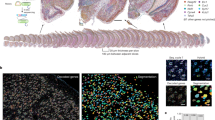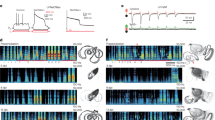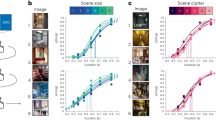Abstract
Synapses made by local interneurons dominate the thalamic circuits that process signals traveling from the eye downstream. The anatomical and physiological differences between interneurons and the (relay) cells that project to cortex are vast. To explore how these differences might influence visual processing, we made intracellular recordings from both classes of cells in vivo in cats. Macroscopically, all receptive fields were similar, consisting of two concentrically arranged subregions in which dark and bright stimuli elicited responses of the reverse sign. Microscopically, however, the responses of the two types of cells had opposite profiles. Excitatory stimuli drove trains of single excitatory postsynaptic potentials in relay cells, but graded depolarizations in interneurons. Conversely, suppressive stimuli evoked smooth hyperpolarizations in relay cells and unitary inhibitory postsynaptic potentials in interneurons. Computational analyses suggested that these complementary patterns of response help to preserve information encoded in the fine timing of retinal spikes and to increase the amount of information transmitted to cortex.
This is a preview of subscription content, access via your institution
Access options
Subscribe to this journal
Receive 12 print issues and online access
$209.00 per year
only $17.42 per issue
Buy this article
- Purchase on Springer Link
- Instant access to full article PDF
Prices may be subject to local taxes which are calculated during checkout








Similar content being viewed by others
References
Bickford, M.E. et al. Synaptic organization of thalamocortical axon collaterals in the perigeniculate nucleus and dorsal lateral geniculate nucleus. J. Comp. Neurol. 508, 264–285 (2008).
Montero, V.M. A quantitative study of synaptic contacts on interneurons and relay cells of the cat lateral geniculate nucleus. Exp. Brain Res. 86, 257–270 (1991).
Van Horn, S.C., Erisir, A. & Sherman, S.M. Relative distribution of synapses in the A-laminae of the lateral geniculate nucleus of the cat. J. Comp. Neurol. 416, 509–520 (2000).
Hubel, D.H. & Wiesel, T.N. Integrative action in the cat's lateral geniculate body. J. Physiol. (Lond.) 155, 385–398 (1961).
Wang, X. et al. Feedforward excitation and inhibition evoke dual modes of firing in the cat's visual thalamus during naturalistic viewing. Neuron 55, 465–478 (2007).
Denning, K.S. & Reinagel, P. Visual control of burst priming in the anesthetized lateral geniculate nucleus. J. Neurosci. 25, 3531–3538 (2005).
Martinez, L.M. et al. Receptive field structure varies with layer in the primary visual cortex. Nat. Neurosci. 8, 372–379 (2005).
Hamos, J.E., Van Horn, S.C., Raczkowski, D., Uhlrich, D.J. & Sherman, S.M. Synaptic connectivity of a local circuit neurone in lateral geniculate nucleus of the cat. Nature 317, 618–621 (1985).
Dan, Y., Atick, J.J. & Reid, R.C. Efficient coding of natural scenes in the lateral geniculate nucleus: experimental test of a computational theory. J. Neurosci. 16, 3351–3362 (1996).
Hirsch, J.A. et al. Functionally distinct inhibitory neurons at the first stage of visual cortical processing. Nat. Neurosci. 6, 1300–1308 (2003).
Hirsch, J.A., Alonso, J.M., Reid, R.C. & Martinez, L.M. Synaptic integration in striate cortical simple cells. J. Neurosci. 18, 9517–9528 (1998).
Acuna-Goycolea, C., Brenowitz, S.D. & Regehr, W.G. Active dendritic conductances dynamically regulate GABA release from thalamic interneurons. Neuron 57, 420–431 (2008).
Güillery, R.W. A quantitative study of synaptic interconnections in the dorsal lateral geniculate nucleus of the cat. Z. Zellforsch. Mikrosk. Anat. 96, 39–48 (1969).
Coomes, D.L., Bickford, M.E. & Schofield, B.R. GABAergic circuitry in the dorsal division of the cat medial geniculate nucleus. J. Comp. Neurol. 453, 45–56 (2002).
Godwin, D.W. et al. Ultrastructural localization suggests that retinal and cortical inputs access different metabotropic glutamate receptors in the lateral geniculate nucleus. J. Neurosci. 16, 8181–8192 (1996).
Montero, V.M. Localization of gamma-aminobutyric acid (GABA) in type 3 cells and demonstration of their source to F2 terminals in the cat lateral geniculate nucleus: a Golgi-electron-microscopic GABA-immunocytochemical study. J. Comp. Neurol. 254, 228–245 (1986).
Govindaiah, G. & Cox, C.L. Metabotropic glutamate receptors differentially regulate GABAergic inhibition in thalamus. J. Neurosci. 26, 13443–13453 (2006).
Wilson, J.R., Forestner, D.M. & Cramer, R.P. Quantitative analyses of synaptic contacts of interneurons in the dorsal lateral geniculate nucleus of the squirrel monkey. Vis. Neurosci. 13, 1129–1142 (1996).
Friedlander, M.J., Lin, C.S., Stanford, L.R. & Sherman, S.M. Morphology of functionally identified neurons in lateral geniculate nucleus of the cat. J. Neurophysiol. 46, 80–129 (1981).
Humphrey, A.L. & Weller, R.E. Structural correlates of functionally distinct X-cells in the lateral geniculate nucleus of the cat. J. Comp. Neurol. 268, 448–468 (1988).
Sherman, S.M. & Friedlander, M.J. Identification of X versus Y properties for interneurons in the A-laminae of the cat's lateral geniculate nucleus. Exp. Brain Res. 73, 384–392 (1988).
Levick, W.R., Cleland, B.G. & Dubin, M.W. Lateral geniculate neurons of cat: retinal inputs and physiology. Invest. Ophthalmol. 11, 302–311 (1972).
Usrey, W.M., Reppas, J.B. & Reid, R.C. Specificity and strength of retinogeniculate connections. J. Neurophysiol. 82, 3527–3540 (1999).
Schwartz, O., Pillow, J.W., Rust, N.C. & Simoncelli, E.P. Spike-triggered neural characterization. J. Vis. 6, 484–507 (2006).
Mante, V., Bonin, V. & Carandini, M. Functional mechanisms shaping lateral geniculate responses to artificial and natural stimuli. Neuron 58, 625–638 (2008).
Koepsell, K. et al. Retinal oscillations carry visual information to cortex. Front. Sys. Neurosci. 3 (2009).
Blitz, D.M. & Regehr, W.G. Timing and specificity of feed-forward inhibition within the LGN. Neuron 45, 917–928 (2005).
Granseth, B. & Lindstrom, S. Unitary EPSCs of corticogeniculate fibers in the rat dorsal lateral geniculate nucleus in vitro. J. Neurophysiol. 89, 2952–2960 (2003).
Pape, H.C. & McCormick, D.A. Electrophysiological and pharmacological properties of interneurons in the cat dorsal lateral geniculate nucleus. Neuroscience 68, 1105–1125 (1995).
Frishman, L.J. & Levine, M.W. Statistics of the maintained discharge of cat retinal ganglion cells. J. Physiol. (Lond.) 339, 475–494 (1983).
Bullier, J. & Norton, T.T. Comparison of receptive-field properties of X and Y ganglion cells with X and Y lateral geniculate cells in the cat. J. Neurophysiol. 42, 274–291 (1979).
Gilbert, C.D. Laminar differences in receptive field properties of cells in cat primary visual cortex. J. Physiol. (Lond.) 268, 391–421 (1977).
Mastronarde, D.N. Nonlagged relay cells and interneurons in the cat lateral geniculate nucleus: receptive-field properties and retinal inputs. Vis. Neurosci. 8, 407–441 (1992).
Fitzpatrick, D., Penny, G.R. & Schmechel, D.E. Glutamic acid decarboxylase-immunoreactive neurons and terminals in the lateral geniculate nucleus of the cat. J. Neurosci. 4, 1809–1829 (1984).
Destexhe, A., Neubig, M., Ulrich, D. & Huguenard, J. Dendritic low-threshold calcium currents in thalamic relay cells. J. Neurosci. 18, 3574–3588 (1998).
Blitz, D.M. & Regehr, W.G. Retinogeniculate synaptic properties controlling spike number and timing in relay neurons. J. Neurophysiol. 90, 2438–2450 (2003).
Hirsch, J.C. & Burnod, Y. A synaptically evoked late hyperpolarization in the rat dorsolateral geniculate neurons in vitro. Neuroscience 23, 457–468 (1987).
Wilson, J.R. Synaptic organization of individual neurons in the macaque lateral geniculate nucleus. J. Neurosci. 9, 2931–2953 (1989).
Dubin, M.W. & Cleland, B.G. Organization of visual inputs to interneurons of lateral geniculate nucleus of the cat. J. Neurophysiol. 40, 410–427 (1977).
Datskovskaia, A., Carden, W.B. & Bickford, M.E. Y retinal terminals contact interneurons in the cat dorsal lateral geniculate nucleus. J. Comp. Neurol. 430, 85–100 (2001).
Bloomfield, S.A. & Sherman, S.M. Dendritic current flow in relay cells and interneurons of the cat's lateral geniculate nucleus. Proc. Natl. Acad. Sci. USA 86, 3911–3914 (1989).
Cox, C.L., Reichova, I. & Sherman, S.M. Functional synaptic contacts by intranuclear axon collaterals of thalamic relay neurons. J. Neurosci. 23, 7642–7646 (2003).
Lõrincz, M.L., Kekesi, K.A., Juhasz, G., Crunelli, V. & Hughes, S.W. Temporal framing of thalamic relay-mode firing by phasic inhibition during the alpha rhythm. Neuron 63, 683–696 (2009).
Cucchiaro, J.B., Uhlrich, D.J. & Sherman, S.M. Electron-microscopic analysis of synaptic input from the perigeniculate nucleus to the A-laminae of the lateral geniculate nucleus in cats. J. Comp. Neurol. 310, 316–336 (1991).
Pasik, P., Pasik, T. & Hámori, J. Synapses between interneurons in the lateral geniculate nucleus of monkeys. Exp. Brain Res. 25, 1–13 (1976).
Person, A.L. & Perkel, D.J. Unitary IPSPs drive precise thalamic spiking in a circuit required for learning. Neuron 46, 129–140 (2005).
Contreras, D., Curro Dossi, R. & Steriade, M. Electrophysiological properties of cat reticular thalamic neurones in vivo. J. Physiol. (Lond.) 470, 273–294 (1993).
Landisman, C.E. et al. Electrical synapses in the thalamic reticular nucleus. J. Neurosci. 22, 1002–1009 (2002).
Butts, D.A. et al. Temporal precision in the neural code and the timescales of natural vision. Nature 449, 92–95 (2007).
Guillery, R.W. A study of Golgi preparations from the dorsal lateral geniculate nucleus of the adult cat. J. Comp. Neurol. 128, 21–50 (1966).
Acknowledgements
We are grateful to L.M. Martinez for discussions throughout the project and thank Q. Wang for custom software. J. Provost, S.X.X. Xing, B. Gary, M. Bathen and M. Gerstmar reconstructed labeled cells, and M. Gerstmar also assisted with event sorting. This work was supported by the US National Institutes of Health (EY09593, J.A.H.), the Redwood Center for Theoretical Neuroscience (F.T.S.) and the National Science Foundation (IIS-0713657, F.T.S.).
Author information
Authors and Affiliations
Contributions
X.W. and J.A.H. performed the experiments with help from V.V. and C.S.S. X.W., J.A.H. and F.T.S. contributed to various analyses, and X.W. and F.T.S. developed the simulations. X.W., J.A.H. and F.T.S. wrote the manuscript, and X.W. prepared all of the figures.
Corresponding author
Ethics declarations
Competing interests
The authors declare no competing financial interests.
Supplementary information
Supplementary Text and Figures
Supplementary Figures 1–4 (PDF 485 kb)
Rights and permissions
About this article
Cite this article
Wang, X., Vaingankar, V., Soto Sanchez, C. et al. Thalamic interneurons and relay cells use complementary synaptic mechanisms for visual processing. Nat Neurosci 14, 224–231 (2011). https://doi.org/10.1038/nn.2707
Received:
Accepted:
Published:
Issue Date:
DOI: https://doi.org/10.1038/nn.2707



